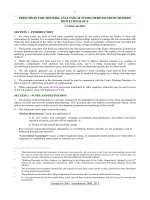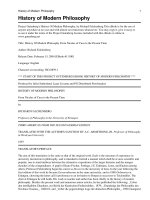ACCURATE ALIGNMENT OF SEQUENCING READS FROM VARIOUS GENOMIC ORIGINS
Bạn đang xem bản rút gọn của tài liệu. Xem và tải ngay bản đầy đủ của tài liệu tại đây (3.35 MB, 193 trang )
ACCURATE ALIGNMENT OF SEQUENCING
READS FROM VARIOUS GENOMIC ORIGINS
LIM JING QUAN
NATIONAL UNIVERSITY OF SINGAPORE
2014
ACCURATE ALIGNMENT OF SEQUENCING READS
FROM VARIOUS GENOMIC ORIGINS
LIM JING QUAN
(B.CompSc.(Hons), NUS)
A THESIS SUBMITTED
FOR THE DEGREE OF DOCTOR OF PHILOSOPHY IN
COMPUTER SCIENCE
DEPARTMENT OF COMPUTER SCIENCE
NATIONAL UNIVERSITY OF SINGAPORE
2014
i
I hereby declare that this thesis is my original work and it has been written by me in
its entirety. I have duly acknowledged all the sources of information that have been
used in the thesis.
This thesis has not been submitted for any degree in any university previously.
________________________
Lim Jing Quan
18/July/2014
ii
iii
I thank my thesis supervisor Dr Sung Wing-Kin for his impeccable patience, selfless
guidance and sharing of his invaluable knowledge over the course of my candidature.
I am also glad to have Prof. Wong Lim Soon and Prof. Tan Kian Lee to be my thesis
advisory committee members. I am thankful to Dr Wei Chia-Lin, Dr Li Guoliang, Dr
Eleanor Wong and Dr Chandana Tennakoon for successful collaboration on some of
the projects, which I have worked on and have eventually made up parts of this thesis.
I would also like to thank Dr Teh Bin Tean, Dr Lim Weng Khong, Sanjanaa and
Saranya from Duke-NUS graduate medical school for accommodating me while I
was still working on this thesis.
The pursuit for knowledge over these years has not been a bed of roses for me. There
was a point of time when I had wanted to quit my candidature. I am grateful that I
have still managed to turn back, pull through and reach ‘this’ particular point of the
thesis. To my comrades whom have made the lab an enjoyable place to work in, I
thank you all in no particular order of favor or seniority: Sucheendra, Chuan Hock,
Javad, Hugo Willy, Hoang, Zhizhuo, Xueliang, Chandana, Rikky, Gao Song, Peiyong,
Ruijie, Narmada, Liu Bing, Difeng, Tsung Han, Benjamin G., Wang Yue, Michal,
Wilson, Hufeng, Chern Han, Mengyuan, Kevin L., Alireza, Ramanathan and Ratul
for inspiration and for contributing to the finishing of this thesis in various ways.
iv
Finally, I would like to thank my family and Chu Ying for their patience. Once again,
I thank all of you for keeping me aspired and hopeful towards the end of my
candidature.
v
Introduction 1
1.1 Introduction 1
1.2 History of DNA Sequencing 3
1.2.1 First-Generation sequencing 3
1.2.2 Second-Generation sequencing 4
1.2.3 Third-Generation sequencing 5
1.3 Motivation 7
1.3.1 Looking at the DNA with an intent 7
1.4 General workflow on sequencing reads 7
1.5 The mapping challenge 8
1.6 Contribution of thesis 9
1.7 Organization of the thesis 11
2Basic Biology and Sequencing Technologies 13
2.1 Basic Biology 13
2.2 Central Dogma of Molecular Biology 15
2.3 Next Generation Sequencing Technologies 17
2.3.1 Roche/454 Sequencing 18
2.3.2 Ion Torrent Sequencing 19
2.3.3 Illumina/Solexa Sequencing 20
2.3.4 ABI/SOLiD Sequencing 21
2.3.5 Comparison 23
2.4 Origins and representations of sequenced data 23
2.4.1 Whole-genome and targeted sequencing 24
vi
2.4.2 RNA-seq – mRNA 25
2.4.3 Epigenetic sequencing 25
2.4.4 Base-space and color-space reads 26
2.4.5 Computational representation of data 28
3Survey of Alignment Methods 29
3.1 Basics of Genomic Alignments 29
3.2 Bisulfite-treated DNA-seq aligners 31
3.2.1 Challenges in aligning BS-seq reads 31
3.2.2 BS-aligner for Base-space reads 33
3.2.3 BS-aligner for Color-space reads 33
3.2.4 Methylation-aware mapping 34
3.2.5 Unbiased-Methylation mapping 35
3.2.6 Semi Methylation-aware mapping 37
3.2.7 Comparison of BS-Seq Aligners 38
3.3 Gapped DNA-seq aligners 40
3.3.1 Challenges in Gapped Alignment 41
3.3.2 Hash/Seed based Approaches 42
3.3.3 Prefix/Suffix trie based approaches 45
3.3.4 Hardware acceleration of seed-extension 48
3.3.5 Comparison of Gapped DNA-Seq Aligners 50
3.4 RNA-seq aligners <stop> 55
3.4.1 Challenges in RNA-seq Alignment 56
3.4.2 Unspliced/Annotation-guided Aligners 57
3.4.3 Spliced Aligner 58
3.4.4 Comparison of RNA-seq Aligners 61
4Bisulfite Sequencing Reads Alignment 65
4.1 Introduction 65
4.2 Related Work 66
vii
4.3 Results 69
4.3.1 Evaluated programs and performance measures 70
4.3.2 Evaluation on the simulated Illumina data 71
4.3.3 Evaluation on the real Illumina data 74
4.3.4 Evaluation on the simulated SOLiD data 76
4.3.5 Evaluation on the real SOLiD data 79
4.4 Materials and Methods 80
4.4.1 Methods for base reads 80
4.4.2 Methods for color reads 85
4.5 Discussion 92
4.6 Conclusions 93
5Gapped Alignment Problem 95
5.1 Introduction 95
5.2 Related Work 96
5.3 Results 97
5.3.1 Simulation study showing that existing methods have difficulties
mapping reads with high mismatches or located near structural variations 98
5.3.2 Evaluation on real reads 108
5.3.3 Evaluation on running times 111
5.4 Methods 111
5.4.1 Methods of experiments 111
5.4.2 Our proposed solution: BatAlign = (Reverse-alignment + Deep-scan) +
Unbiased mapping of paired reads 115
5.4.3 Details of algorithms in BatAlign 116
5.5 Conclusion 120
6Spliced Alignment Problem 123
6.1 Introduction 123
6.2 Challenges in Spliced Alignment 124
viii
6.3 Related Work 125
6.4 Results 126
6.4.1 Setup of experiments and performance measures used 126
6.4.2 Evaluation on the simulated RNA-seq Illumina-like reads 127
6.4.3 Evaluation on real RNA-seq Illumina-like reads 130
6.5 Evaluation on running time 134
6.6 Methods 135
6.6.1 Simulation of data and validation of simulated data 136
6.6.2 Overview of Method 136
6.6.3 Motivation for using BatAlign as a seeding tool 137
6.6.4 Phase 1 – Resolve exonic region within a single read 138
6.6.5 Phase 2 – Search for junctions from an anchored region 139
6.6.6 Phase 3 – Refine alignments due to splice junctions near ends of reads
……………………………………………………………………… 141
6.6.7 Data structure for efficient pairing of genomic coordinates 143
6.6.8 Details of implementation 144
6.6.9 Discussion 145
7Conclusion 149
7.1 BatMeth 149
7.2 BatAlign 150
7.3 BatRNA 151
7.4 Future Developments 152
Bibliography 153
Appendix A 167
ix
Sequencing technologies have revolutionized the study of genomes by generating
high throughput data for various studies which are not cost-efficient when done with
Sanger sequencing. The first step in analyzing these high throughput data is often to
find the original location from which the data reads are sequenced from a reference
genome. Moreover, references genomes can be very large (human genome ~3.2GB).
This calls for better methodologies in aligning reads onto a reference genome.
In this thesis, we present three methodologies in producing accurate alignments of
DNA-sequencing reads with bisulfite-induced nucleotide conversion, DNA-
sequencing reads with mismatches and gaps, and RNA-sequencing reads with
intronic spliced junctions.
Our first contribution is BatMeth; a fast, sensitive and accurate aligner for DNA-
sequencing reads derived from sodium bisulfite treatment. BatMeth is designed to
handle both base-space and color-space bisulfite-treated reads. Based on List-
Filtering, Mismatch-Stage-Filtering, BatMeth was able to avoid examining spurious
hits and improve the efficiency and specificity of our alignment. Our experiments
also show that BatMeth can produce better methylation callings across samples of
different bisulfite conversion rates.
BatAlign is our next contribution which can align DNA-sequencing reads in the
presence of both mismatches and insert-delete (indel) accurately. Two novel
x
strategies called Reverse-Alignment and Deep-Scan are developed to enable the
efficient reporting of accurate alignments for these reads. Reverse-Alignment starts
the alignment of a read by looking for the most probable preliminary alignments
incrementally. Deep-Scan refines the preliminary alignments by searching for a
targeted subset of less probable alignments to better distinguish the best alignment
from the rest. BatAlign was able to achieve competitive runtime efficiency with
SIMD-enabled Smith-Waterman algorithm for the extension of seeds from a long
read in our seed-and-extend strategy.
Our last contribution is BatRNA is designed to recover splice alignment of a RNA-
sequencing read sensitively and efficiently. As RNA-sequencing datasets can have
very varying mixture of exonic and spliced reads in them, BatAlign was introduced in
BatRNA as a pre-mapping tool to draft up the possible spliced sites of the genome.
After which, we filtrate the reads from the mappings of BatAlign to be mapped by
BatRNA for possible spliced alignments of the reads. The resultant mappings from
both BatAlign and BatRNA are considered for the final alignment of a read.
Compared with other popular and recent RNA-sequencing aligners, BatRNA was
able to produce very sensitive and accurate alignments in a dataset of mixed exonic
and spliced reads, while maintaining competitive runtimes.
In summary, we have developed various methodologies to align reads on to a
reference genome, sequenced from various genomic origins, accurately and
sensitively.
xi
Table 2.1. Comparison between some commercialized sequencing platforms in the
market. 23
Table 3.1. The possible text-edit operations that can be represented by a CIGAR for
the alignment of a query string onto a reference text 30
Table 3.2. Methods for the alignment of Bisulfite-seq data and their performance
measures 39
Table 3.3. Methods for gapped alignment and their respective main indexing/mapping
strategies 51
Table 3.4. Methods for RNA-seq alignment and their respective mapping strategies
and usage of annotations for spliced alignments 62
Table 4.1. Comparison of mapping efficiencies and estimation of methylation levels
in various genomic contexts 74
Table 4.2. Comparison of speed and unique mapping rates on three lanes of human
BS data 75
Table 4.3. Unique mapping rates and speed on 100,000 real color reads 79
Table 4.4. Possible ways to map a BS read onto the converted genome 82
Table 4.5. Cutoffs for list filtering on simulated reads from the Results section 84
Table 4.6. Possible ways to map a BS color read onto the converted color genome 87
Table 5.1. Cross-comparison of sensitivity at similar specificity and vice versa for
simulated datasets of 75/100/250 bp 103
xii
Table 5.2. Number of first (or best) alignment reported by various methods on
simulated 100bp dataset 104
Table 5.3. F-measures of SV-callings against oracle information from Bioconductor’s
RSVsim package at various down-sampled rates of the dataset from an original depth
of 30X. 107
Table 5.4A. Comparison on the number of SVs recalled across various sub-sampled
data of published and validated SVs of Patient 46T through manual counting of
supporting real-pairs. 110
Table 5.4B. Total number of putative SVs called from across various sub-sampled
data of Patient 46T 110
Table 5.5. Comparison of running times across all compared programs on 1 million
reads from SRR315803 111
Table 6.1. The F1-scores of the compared methods on BEERS-simulated 2M datasets.
128
Table 6.2. Breakdown of alignment performance by exonic and spliced reads using
simulation 129
Table 6.3a. Tabulation of correct hits ranked by the order in which they were reported
for a read. 130
Table 6.3b. Tabulation of wrong hits being reported alongside a rank-k correct hit.130
Table 6.4. Wall-clock time of compared methods on different sets of 2 million reads.
135
xiii
Figure 1.1. General workflow on sequencing reads 8
Figure 2.1. Schematic diagram of a typical animal cell 13
Figure 2.2. Two main types of genomic tasks and their respective downstream
analysis. De novo tasks involve the manipulation of read data without a reference
genome. Profiling tasks use the alignment of the read on a reference for analysis. 15
Figure 2.3. The general cases of the central dogma of molecular biology for
eukaryotic cells 16
Figure 2.4. Schematic diagram of bridge amplification forming cluster stations.
Source: [58] 21
Figure 2.5. Workflow of ligase-mediated sequencing approach from ABi SOLiD.
Source: [58] 22
Figure 2.6. 2-base encoding scheme used by SOLiD sequencers. Source: [58] 27
Figure 3.1. PCR amplification of bisulfite treated genomic DNA. The original strands
of the DNA undergo bisulfite conversion with unmethylated-C changing to U and
methylated-C remaining unchanged after the treatment. Methylated (Red) and
Unmethylated (Green). 32
Figure 4.1. (a,b) Base call error simulation in Illumina and SOLiD reads reflecting
one mismatch with respect to the reference from which they are simulated in their
respective base- and color-space. (b) A naïve conversion of color read to base space,
for the purpose of mapping against the base space reference, is not recommended as a
single color base error will introduce cascading mismatches in base space. (c) A BS
xiv
conversion in base space will introduce two adjacent mismatches in its equivalent
representation in color space 68
Figure 4.2. Benchmarking of programs on various simulated and real data sets (a)
Benchmark results of BatMeth and other methods on the simulated reads: A, BatMeth;
B, BSMAP; C, BS-Seeker; D, Bismark. The timings do not include index/table
building time for BatMeth, BS-Seeker, and Bismark. These three programs only
involve a one-time index-building procedure but BSMAP rebuilds its seed-table upon
every start of a mapping procedure. (b) Insert lengths of uniquely mapped paired
reads and the running times for the compared programs. (c) Benchmark results on
simulated SOLiD reads. Values above the bars are the percentage of false positives in
the result sets. The numbers inside the bars are the number of hits returned by the
respective mappers. The graph on the right shows the running time. SOCS-B took
approximately 16,500 seconds and is not included in this figure. (d) BS and non-BS
induced (SNP) adjacent color mismatches 73
Figure 4.3. A total of 106, 75 bp long reads were simulated from human (NCBI37)
genomes. Eleven data sets with different rates of BS conversion, 0% to 100% at
increments of 10% (context is indicated), were created and aligned to the NCBI37
genome. (a-e) The x-axis represents the detected methylation conversion percentage.
The y-axis represents the simulated methylation conversion percentage. (f) The x-axis
represents the mapping efficiency of the programs. The y-axis represents the
simulated methylation conversion percentage of the data set that the program is
mapping. (a,b) The mapping statistics for various genomic contexts and mapping
efficiency with data sets at different rates of BS conversion for BatMeth and B-
SOLANA, respectively. (c-e) Comparison of the methylated levels detected by
BatMeth and B-SOLANA in the context of genomic CG, CHG and CHH,
respectively. (f) Comparison of mapping efficiencies of BatMeth and B-SOLANA
across data sets with the described various methylation levels 78
xv
Figure 4.4. Outline of the mapping procedure. (a) Mapping procedure on Illumina BS
base reads. (b) Mapping procedure on SOLiD color-space BS reads 83
Figure 5.1. A) The sensitivity and specificity of compared methods on k-mismatch
reads which can be mapped uniquely with k-mismatch. B) shows similar statistics to
A) by mapping k-mismatch reads which have alternate unique alignment of k-
mismatch 100
Figure 5.2. The differences in sensitivity and specificity between mapping paired-end
datasets with simulated concordant and discordant paired-end information. 101
Figure 5.3. Sensitivity and accuracy for aligning simulated reads from ART.
Cumulative counts of correct and wrong alignments from high to low mapping
quality for simulated Illumina-like (A) 75 bp and (B) 100 bp (C) 250bp data- sets. 102
Figure 5.4. Sensitivity and specificity on mapping of concordant and discordant
datasets using paired-end mapping mode of various methods. Data points circled in
red depicts mapping performance on discordant dataset. 106
Figure 5.5. Concordance and discordance rates of alignments on real reads.
Cumulative counts of concordant and discordant alignments from high to low
mapping quality for real sequencing reads (A) 76 bp and (B) 101 bp (C) 150bp data-
sets. 109
Figure 6.1. The counts of (a) correct alignments and (b) wrong alignments from the
compared methods on 76 bp and 100 bp BEERS-simulated datasets 127
Figure 6.2. Chromosome-1 reads were mapped to a chromosome-1-deficit hg19.
False positive rate was calculated by the number of simulated reads that were mapped
to the modified hg19, divided by the total number of reads. 131
Figure 6.3. The counts of correct and wrong alignments for simulated RNA-seq 76bp
and 100bp of 2 million reads each stratified by edit-distances of 0 to 3 133
xvi
Figure 6.4. The cumulative counts, over edit distances of 0-3, of all non-ambiguous
mappings from the various spliced mappers on 2 million real reads taken from
Sample 11T of ERP00196. 133
Figure 6.5. The cumulative counts, over edit distances of 0-3, of all non-ambiguous
spliced mappings from the various spliced mappers on 2 million real reads taken from
Sample 11T of ERP00196. 134
Figure 6.6. A schematic flowchart showing how input RNA-seq reads is aligned using
the 3-phased methodology of BatRNA 137
Figure 6.7. Possible alignments on RNA-seq read from BatAlign. 139
Figure 6.8: A flowchart showing how the splice alignment algorithm in BatRNA
performs splice alignment 141
Figure 6.9. Schematic sketches of some possible scenarios that can happen in
BatRNA splice algorithm. a) Adjacent non-overlapping seeds do not span across
exon-exon junctions. b) Anchored seed is near to an exon-exon junction and next
immediate 18-mer is used to seed the alignment. c) After successfully pairing of seeds
within spanning distance of 20 kbp, alignments are extended towards each other to
recover the splice junction on the reference genome. d) New seed is selected for the
continual extension of a current partially anchored alignment. 142
Figure 6.10. Possible short overhangs being recovered with local alignment by using
preceding prediction as a guide in an unsupervised manner 143
Figure A.1. Three postulated methods for DNA replication prior to Meselson-Stahl
experiment 168
Figure A.2. Schematic diagram of DNA replication at a replication fork. 168
Figure A.3. Illustration of introns and exons in pre-mRNA and the maturation of
mRNA by splicing. 171
1
1.1
Earth has been brimming with life for as long as we can remember. Being intellectually
revolutionized agents, it is imminent for us to question and understand the ravels of life.
As some may have known it as “The Code of Life”, DNA has been understood to be the
determinant material that guides the molecular operations and propagation of organisms.
Pioneers such as Charles Darwin and Gregor Mendel first studied the rules of such
propagates between the years of 1856 and 1865.
In 1859, Charles Darwin published his theory of evolution with inspiring evidences in a
book titled “On the Origin of Species” [1]. He showed that all species of life have
descended from common ancestors and rejected competing explanations of species being
transmuted from one and another. This scientific theory proposed a branching pattern of
evolution for different species resulted from a process, which he has coined as Natural
Selection. While the theory of Natural Selection was centered on the communal pressure
for survival in an ecosystem, Gregor Mendel focused on the passing of phenotypes from
2
parents to its offsprings of the same species. Mendel’s experiments on plant hybridization
led to the understandings on how the propagation of dominant and recessive phenotypes
in a species was carried out in the form of inheritable materials [2], which we now call it
as genes. It was not until 1940s that Darwin’s theory of Natural Selection and Mendel’s
Law of Inheritance were combined to give rise to evolutionary biology.
DNA is made up of genes, which gave phenotypic traits to an organism. It was first
isolated as a weak acid and was identified as the genetic material in 1944 by Oswald
Avery, Colin MacLeod and Maclyn McCarty [3]. Within the next decade, science
celebrated the ground-breaking discovery on the structure of DNA with the publication of
three papers by Nature: one from James Watson and Francis Crick of Cambridge
University that proposed the double helix sugar-phosphate backbone structure of the
DNA [4], and two accompanying papers from Franklin Rosalind [5] and Maurice Wilkins
[6] of King’s College, London, who used X-ray diffraction images to support the helical
structure of DNA.
After the DNA double helix structure was discovered, scientists moved on to investigate
the contents of what it holds, in particular, the sequences of nucleotides that form genes.
DNA was sequenced for the first time in early 1970s by Frederick Sanger [7], Walter
Gilbert and Allan Maxam [8], and were published independently in 1977. Sanger
sequencing was the first established method to sequence long stretches of DNA and had
partially been used to produce the first draft of the human genome, known as the Human
Genome Project (HGP), starting from 1990 and to its completion in 2003 with a working
draft of the human genome [9].
3
Due to the influx of funding and talent into the field of genomics, huge advances in
sequencing technologies were achieved and also gave rise to a new generation of
sequencing technologies which we call second-generation sequencing (SGS) technologies.
With SGS technologies at the disposal of scientists, landmark projects were launched.
After the HGP, scientists went on to sequence the genomic sequences of a wide variety of
species from various clades such as mammal, nematode and insect. Some examples
included humans of different ethnic groups and different strains of influenza viruses.
Alongside with DNA sequencing projects, Human Encyclopedia of DNA Elements
(ENCODE) project was also launched in 2003 to build a comprehensive list of functional
elements of the human genome. ENCODE projects encompassed the studies of genetic
elements that acted at the RNA level, protein level, and regulatory elements that control
cellular functions[10]. As of 2012, ENCODE had claimed to have assigned biochemical
functions for 80% of the human genome [11].
1.2
DNA sequencing is the process of determining the precise order of nucleotides within a
DNA molecule. In 1977, the first whole DNA sequence was obtained, from the entire
genome of bacteriophage Φ–X174, using chain-termination methods [12]. This
sequencing method was developed in 1975 by Sanger [13] and followed independently
by Maxam and Gilbert in 1977. The Maxam-Gilbert method was more laborious and
hazardous to handle, as the chemicals used in the sequencing procedures were more
radioactive than Sanger’s method. Due to these reasons, Sanger sequencing became
dominant and was representative of first-generation sequencing methods. Even till now,
Sanger sequencing is still practiced due to the longer read-lengths, ~800 bases in average,
4
that it can generate as compared to ~100 bases long reads from Illumina GA IIx machines
[14]. Sample preparation for Sanger sequencing starts by generating randomly sized
fragments from the same DNA fragment. The ends of these differently sized fragments
are then labeled respectively with one of the four fluorescent dyes which substitutes for
each of the four nucleotides of the DNA – adenine, cytosine, guanine and thymine. Next,
the dye-ended fragments are ran across an agarose gel and will be separated by their
lengths. Lastly, the sequence of the DNA sample is determined from the last base of the
fragments as depicted by the order of their relative positions in the gel. Although, this
method can be fully automated to sequence long stretches of DNA, it still took about 13
years and three billion dollars to produce the first working draft of the human genome for
the HGP. The main drawback of Sanger sequencing is that the throughput of each run is
too low to perform in-depth studies on the complex dynamics of the human genome.
This wave of technologies aimed to offer numerous advantages over Sanger sequencing
in the form of (1) shorter runtime (increasing sequencing speed); (2) higher throughput
(sequencing more bases within shorter periods of time); (3) cheaper sequencing costs
(less reagents were needed for the experiments) and (4) higher accuracy (enabling
discovery of rare-occurring variants).
The second generation of sequencing (SGS) was first described by two publications in
2005 [15, 16]. The initial impacts that polony sequencing had brought about was the
lower sequencing costs and the potential for scientists to capture the complex dynamics
of the genome at high resolutions. A year later, two Cambridge scientists developed the
Solexa 1G sequencer and it was able to produce a throughput of 1 giga-base in a single
experimental run for the first time in history using reversible terminator chemistry [17].
In the same year of 2006, Agencourt was purchased by Applied Biosystems which
5
introduced SOLiD sequencing [18] which too had the ability to sequence a genome as
complex as the human genome. Other SGS technologies include Roche 454
pyrosequencing [19], IonTorrent semiconductor sequencing [20], DNA nanoball
sequencing [21] and Heliscope single molecule sequencing [22]. With most SGS
technologies, strands of identical DNA were anchored to a fixed location to be read by a
sequential series of label-scan-wash cycles. Each of this cycle will yield a read-base and
will no longer continue when the series of label-scan-wash cycles fall below a threshold
of quality. Due to the high density of DNA that can be packed into a single sequencing
template platform, the throughput from such technologies far exceeded of those of Sanger
sequencing [14]. This has directly made quantification of transcripts, genome-wide
methylation profiling and many other studies possible.
More cost-effective methods were also developed to compromise between the competing
goals of genome-wide coverage and cost-effective targeted-coverage. An example will be
“exome sequencing” whereby ~1% of the human protein-coding genome was targeted for
sequencing [23, 24].
Sanger sequencing and SGS technologies have by far revolutionized the field of
genomics. However, there are still aspects of genome biology that are still beyond the
capabilities of SGS technologies. The main shortcomings of SGS technologies are the
long runtime (a few days), short read-lengths and potentially high sequence bias and/or
sequencing errors. The large number of label-scan-wash cycles required to generate a
read has to be synchronized and a lot of overhead has resulted before the next subsequent
cycle can start. This caused the time needed to generate viable reads of long read-lengths
to be long. It is also due to the fact that the label-scan-wash cycles have to be
synchronized in-between cycles. This means that the yield of each step of the series of









